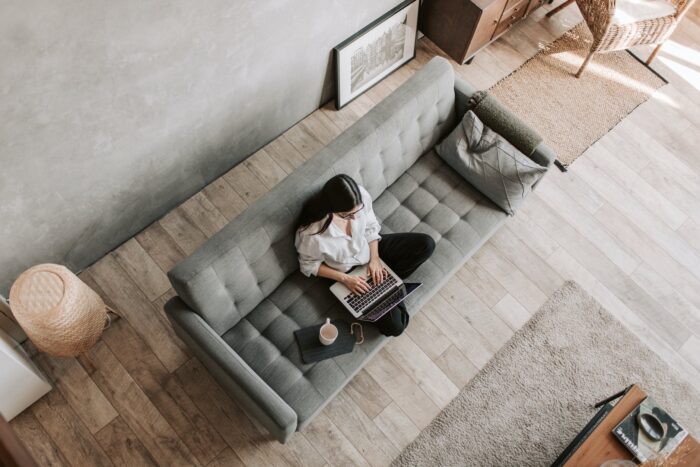
So much of productivity and focus is defined by our physical surroundings. If you’re in a place where you’re uncomfortable or distracted, you won’t get much done. But if you’re in a place where you’re able to reach a state of flow with ease, good things will happen.
What is Flow? (And Why Does it Matter?)
Psychologists use the term “flow” to describe a state of mind in which a person becomes utterly consumed in the work they’re doing. It’s a state of total focus, enjoyment, pleasure, and fulfillment.
As positive psychologist Mihaly Csikszentmihalyi describes it, “The ego falls away. Time flies. Every action, movement, and thought follows inevitably from the previous one, like playing jazz. Your whole being is involved, and you’re using your skills to the utmost.”
While flow is something most people equate to artistic or athletic pursuits like music, writing, dancing, or performance, it can be reached in any setting or occupation. Yes, even the accountant or HR professional can reach a state of flow. Flow makes everything more enjoyable. But it does much more than this. It also has a number of other advantages, including:
1. Increased focus

When you’re in a state of flow, it’s impossible to engage with anything other than the task at hand. Everything else seems to disappear and 100 percent of your focus is channeled.
2. Improved performance

Researchers have found a strong correlation between flow and performance in a variety of areas and specialties, including art, learning, teaching, and athletics.
3. Greater creativity

When people reach a state of flow, the creative centers of the brain kick into high gear. This results in unique and original ideas/work that would otherwise be impossible to create in a distracted state of mind.
4. Superior emotional regulation

As flow increases, people tend to have a much greater level of emotional complexity. In other words, they’re able to regulate emotions more fully. This leads to superior results on many levels.
By putting yourself in a position to experience flow more often, you give yourself the opportunity to consistently tap into benefits such as these. And for the remote worker, it all starts with designing a home office that you actually want to work in.
- Designing a Flow-Friendly Home Office
A flow-friendly office starts with a plan. Here are a few tips to help you get started:
Select the right Location
The right location is paramount. You want your home office to be situated in an area of the home where foot traffic and noise are kept to a minimum.
Even if you live by yourself, it pays to have a secluded place that’s reserved for work. (The kitchen table doesn’t count.) Your brain needs a level of separation between work and personal life. If everything happens in the same location, it’s difficult to reach a state of flow/productivity.
Purchase the Right Furniture

The right furniture makes a big difference in the office. Companies like BTOD.com specialize in ergonomically-friendly desk chairs, standing desks, and other pieces of furniture that are designed to make workspaces more comfortable and efficient.
Block Out Distractions

When transitioning from a traditional office to a home office, people often assume it’ll be much easier to focus. After all, you no longer have to deal with noisy coworkers and constant interruptions from your boss. But in reality, these distractions are simply replaced with new ones.
Working from home creates challenges with work-life balance. Laundry, dishes, yardwork, children doing homework – personal obligations can easily add up and conquer your attention. The only way to address this issue is to be systematic in how you approach distractions. For one, you have to create ground rules with anyone else who lives in your home.
Whether it’s a spouse, child, or roommate, make sure everyone knows your work hours (and the expectations you have for noise, interruptions, and the like). Secondly, be aware of what triggers you to stop working and indulge in time-wasting behaviors. Because whether you realize it or not, there are two or three factors that are to blame.
“Oftentimes, you’re not able to recognize these stressful emotions immediately, so pose a few helpful questions to yourself, such as ‘What was it that stressed me out just now?’ and ‘What am I trying to avoid here?” Fast Company suggests. “A purposeful amount of self-reflection will prevent you from falling down a rabbit hole of YouTube playlists instead.”
It’s impossible to block out 100 percent of distractions. However, the more you prioritize your focus, the less time you’ll waste on them.
Get the Lighting Just Right

Lighting has a major impact on productivity and focus. When possible, integrate as much natural lighting as possible into your home office. If windows are limited, go with warm and soft lighting, rather than harsh, white light that’s known to cause eye strain and irritation.
Consider This ‘Forgotten’ Sense
When we think of the five senses within the context of an office setting, sight, sound, and touch typically get most of the attention. But, believe it or not, scent is just as important. In fact, the right smell can have an incredibly positive impact on your mood and mindset (both of which fuel or hinder productivity).
While there’s nothing wrong with a neutral scent, sometimes you need a bit of a boost to keep you focused and productive. In this case, here are a few scents that are known to be beneficial:
- Citrus: Increased alertness and focus
- Cinnamon: Improved focus
- Peppermint: Elevates mood and increases optimism
- Lavender: Relaxes the mind and promotes emotional balance and regulation
- Pine: Increases overall alertness
The best way to introduce these scents into your home office is to diffuse essential oils. Essential oils are safer than candles and are totally clean (meaning they emit no toxins or chemicals).
Design a Home Office That Works for You

No two home offices will ever be the same – and that’s a good thing. You want an office that’s totally personalized and tailored to your needs, strengths, and goals. By applying a few of the techniques outlined above, you’ll find it easier to create an office that helps you achieve that elusive state of flow that most of your peers can only dream about.














